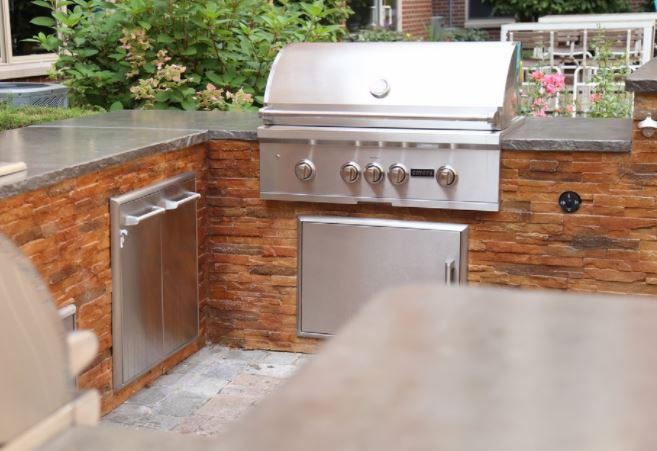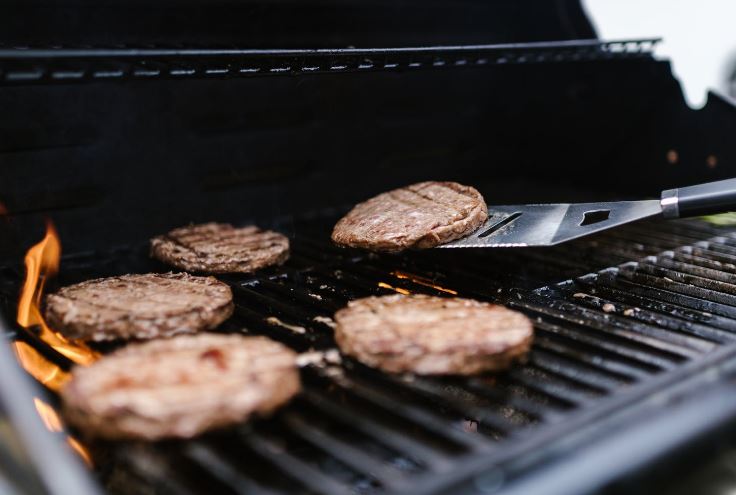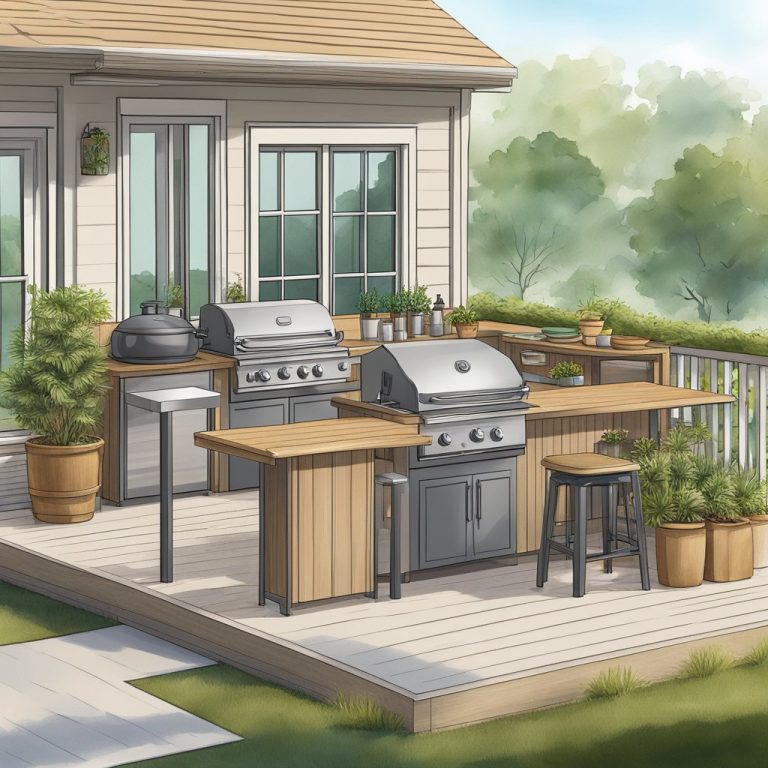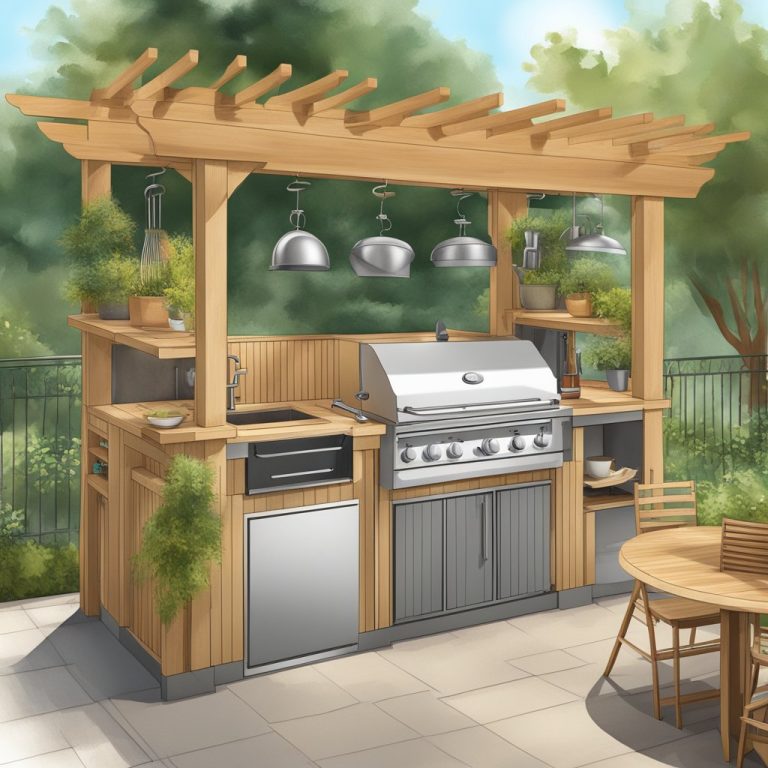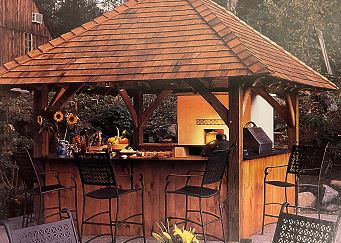How Far Should a Built In Grill Be From a House?
What Distance Away From Your House Should You Put a Built in Grill?
Designing and locating your outdoor kitchen is one of the most important decisions you have to make.
Too far from the house and you run the risk of wasting time going back and forth from your indoor kitchen to your outdoor one to get supplies. Too close to the house and you will have issues with cooking smoke and heat entering the home every time you open the back door. Locate a gas grill far away from the home and the natural gas line might need to be run further and those costs will add up.
Then there’s the issue of safety. Especially concerning grills. If the grill is too close to the house, there could be smoke or heat damage to exterior building materials.
So what exactly is the best distance from the house for a grill?
For maximum safety, ten feet from the house is the recommended distance prescribed by the Consumer Product Safety Commission. Manufacturers, however, suggest three feet.
Grill Safety Basics: How Far Away From The House Should A Built-In Grill Be?
To avoid damage, a barbecue should be kept a safe distance away from the house. The most common type of damage caused by a grill’s heat is likely vinyl siding damage. When a grill is put too close to siding, it can buckle or burn. The siding or other material catching fire would be the worst-case scenario. A grill also requires sufficient ventilation to prevent the development of smoke, carbon monoxide, and gas from gas grills.
How far away from the house should a built-in barbecue be? Once you’ve decided that a built-in grill is a must-have for your home, you’ll need to figure out where you’ll put it. You may believe that the closer the grill is to the home, the better, or you may wish to construct a separate outdoor room for grilling outdoors. Finding the perfect site and resources to use are just the beginning of the process.
While scouting locations for your new built-in grilling station is an educational experience, there are some important safety issues to keep in mind before you begin. At the top of that list is determining how far your built-in barbecue should be from the house, including any overhangs.
1. The Benefits of Keeping Your Built-In Grill Close to the House
Because it is custom-made for your backyard, many homeowners prefer to install a built-in grill. This unique location can boost the value of your property if you incorporate it into a bigger outdoor kitchen.
During the summer, an outdoor kitchen is a great place to meet friends and family to celebrate special occasions and cook delicious meals. A built-in barbeque can help define an entertaining area in your garden.
If you expect to use your new barbecue frequently, it’s important to keep it close to your home. It’s quite convenient to have it right outside a back or side door for taking out items and avoiding the summer heat in between grill check-ins.
There may be an overhang in that region that provides protection from the elements for you and your barbecue.
You can still be convenient, albeit your grill may need to be positioned a little more away than you would want. You can cover your barbecue grilling area with a cover to keep the rain and heat off of you. You can also use a remote thermometer to monitor the temperature of your grill and food from afar, reducing the number of trips back and forth from the house.
2. How far away from the house should your built-in grill be?
Because there’s a risk of fire anyplace there’s heat, the first need for a built-in grill is that it be placed far enough away from the home to keep everyone safe. A built-in grill, unlike a standalone barbecue, cannot be moved away from the house when in use. (Always remember to keep a fire extinguisher close by just in case.)
Spacing is critical whether you’re using a gas, charcoal, or pellet grill. As mentioned earlier, many builders and the US Consumer Product Safety Commission recommend that you keep your grill at least 10 feet away from any structure, especially combustible overhangs like awnings. A less cautious recommendation, commonly stated by manufacturers, is at least 3 feet away from a dwelling.
Certain surfaces, particularly stucco, can become soot and grease stained from grills that are located too close.
When deciding how far away from your house to position your grill, keep the following in mind.
Local Building and HOA Regulations
Building rules differ greatly amongst towns, so check to see whether your city or county has a requirement for the distance between grills and structures. Houses, property-dividing fences, or a neighbor’s structure are all examples of this.
If you live in a house with a homeowners’ association, find out what rules apply regarding grill location and the addition of structures. To install an overhang, you may need permits or authorization from the HOA first.
Homeowner’s Insurance Policy Coverage
Examine your homeowner’s insurance policy for any restrictions or guidelines on how close a grill or outdoor kitchen can be to the main structures.
Grill Manufacturer Recommendations
Your grill’s manufacturer will also provide parameters, such as the recommended distance from the house. As long as there are no protruding overhangs, the 3′ proposal is frequently used.
While the most common question is how far away a built-in barbecue should be from the house, another worry is the available space above your grill. There must be at least 8′ of free space above the grill if you choose to build your outdoor grill station in a carport, under an awning, or under a cover.
If the overhang is made of flammable materials, such as wood, a vent hood may be required. You may need to address this specification with your local building codes and insurance needs.
3. Why is it important to grill away from a structure?
While it may seem self-evident that grilling should be done at a safe distance from the home, there are a few factors to consider.
Increase the flow of air
Spacing is needed to prevent gas or carbon monoxide buildup with proper air gap levels to permit ventilation. Any build-up might result in unexpected flare-ups and fires that spread swiftly.
Smoke damage should be minimized
There’s smoke where there’s fire. You want the smoke that emanates from your grill to dissipate properly in the surrounding air. Smoke damage can occur over time if your built-in barbecue is placed too close to the house or under an eave or awning.
Damage to the siding should be avoided
The heat from your grill might cause your home’s siding to deteriorate. Vinyl siding can melt when exposed to high temperatures from a grill. Other dangers of loose or rippling siding include structural damage, leaks, and even building movement. This might be problematic, especially if you plan to sell your home in the future.
If your home has vinyl siding, you must keep your barbecue at least 10 feet away from it.
Fire-Retardant Materials and More Reduce the Risk of Fire and Damage
Once you’ve found the perfect spot for your built-in grill, prepare the area with fire-resistant materials to add an extra layer of safety. These materials can be strategically placed to protect wall areas and any overhangs, limiting the potential for a fire to spread to your home.
Materials that are fire-resistant include:
Stainless steel
Stone, granite, or travertine
Bricks
Stone veneer
Metal corrugated panels
How to Grill Safely
The materials you use to construct your grilling station can increase your safety and offer you with piece of mind. You’ll be less concerned about leaving the grill alone as it cools or the charcoal burns out. As a general rule for grilling safety, keep a fire extinguisher accessible for quick access in the event of a fire.
A final caution from the Consumer Product Safety Commission:
Because of the dangers of carbon monoxide (CO) and fire, never use a grill indoors. Also, keep the barbecue at least 10 feet from your house or any other structure.
In a garage, breezeway, carport, porch, or under a surface that will ignite, do not use the grill.

